Why Diversity Behind the Camera Is Just as Important as on Screen

For the past few years at the Cannes Lions advertising festival, diversity has taken a prominent place onstage in an industry that was known for decades for being overwhelmingly white and male. This year, the conversation has changed. Market conditions as well as heavily publicized cultural backlash have caused many advertisers to pull back on lofty initiatives to prioritize diversity everywhere from their ad creative to their employee workforces.
But the reality remains: 54% of consumers say they feel underrepresented in advertising, according to a 2024 survey by the World Federation of Advertisers (WFA) about diversity, equity, and inclusion (DEI) in ad production. And 82% prefer to patronize brands that match their values. Clearly, there’s reason for advertisers to prioritize reaching diverse audiences in a way that those audiences and the individuals within them find authentic.
But often that commitment to diversity doesn’t extend to behind the camera, and that was the subject of a panel hosted at the Infillion Café at Cannes Lions, “Beyond the Buzz: How DEI in Production Elevates Creative Effectiveness.” According to the WFA report, only a third of advertisers have actively been incorporating DEI practices into their production processes over the course of the past five years.
“When it came to production, there was hardly any guidance available for the average marketer,” explained Efrain Ayala, global creative effectiveness and diversity and inclusion director at Reckitt, who worked on the WFA report and spoke on the Cannes panel. This extends to everything from partner selection to the technology being used to the environment created on set.
Panel moderator Shazzia Khan, chief talent and innovation officer at Havas, said that “you just have to make sure that everything is integrated from A to Z.” But that’s not always intuitive for brands and agencies, and it requires a kind of scrutiny that’s often only paid to the creative itself.
“You really need to reward folks who are putting in the work and it all comes down to accountability and tracking in the numbers,” said Taryn Crouthers, president of creative agency ATTN, on the Cannes panel. “Operations and production are undersung heroes.”
“Behind the camera there’s a huge gap in terms of equal opportunities,” Efrain Ayala said. “How many times are brands telling their agencies, ‘I want a more diverse cast’” – but at the same time, they aren’t thinking about the hair, makeup, and wardrobe needs that best cater to people from diverse backgrounds.
Derrick Johnson, president and CEO of the NAACP, chimed in that the famed organization’s annual Image Awards have expanded to honor talent in less visible fields like hairstyling and makeup artistry. “There’s a whole set of industries that are behind the camera,” he said.
The Urgency Created by Generative AI
Diversity in production is particularly important because of a recent development in the industry: generative AI. Several high-profile misfires have highlighted that many generative AI technologies have been built by teams that didn’t have inclusion in mind, or that were trained on data sets that reflected a narrow worldview. That’s a problem as generative AI becomes increasingly crucial in advertising.
“You have to think about AI consciously. Are you using out-of-the-box tools, and if you’re using out-of-the-box tools, how do you ensure that the data that those tools rely on isn’t riddled with bias?” Efrain Ayala said. If you are, he explained, “you’re basically automating some of the worst parts of what the industry’s done before.” At events like Cannes Lions, there’s plenty of hype about generative AI. But as Ayala observed, at flashy industry conferences “you don’t often hear about how we’re making sure [generative AI] doesn’t spit out garbage that alienates or relies on harmful stereotypes.”
The solution here can lie in seeking out the AI tools that might not be the biggest or best-known, but which have been built with inclusion in mind. “We are looking at the founders and elevating underrepresented voices who are leaders in AI, because I think that’s how we’re really going to get to the root of the problem,” said Taryn Crouthers.
Approaching DEI Holistically
Part of the problem is that when the ad industry talks about creativity, it’s often only talking about certain parts of the business. “It all comes down to creativity and so when you think about the future, how you can really be responsible in your efforts, I would look internally at your teams for the problems you’re trying to solve,” Crouthers said. “Creativity shouldn’t just sit with creatives, or with a producer or an editor. It should sit in your procurement department, it should sit in your operations team, it should sit in your casting.”
And above all, it requires real commitment rather than lip service.
“Don’t be patronizing. Don’t think that you can write a check to solve a problem,” said Derrick Johnson. “Start now, aggressively, to ensure that the level of inclusion that should’ve been there all along is there.”
Infillion’s TrueGiving initiative is dedicated to building pro bono campaigns for the diverse organizations that are changing the world. Learn more about it here.
Subscribe to our blog:
Related Posts:

Why Neurodiversity Will Lead The Way In The AI Era
One in five employees today identifies as neurodivergent – as having autism, ADHD, dyslexia, or other cognitive variations – and that’s only going to grow. According to research from ZenBusiness, fully half of Gen-Z identifies with neurodivergence on some level....

How Brands Can Win In Times Of Uncertainty
The 2020s have been defined by relentless uncertainty across every industry. For brands and advertisers, it’s been one curveball after another - with the pandemic, AI, and inflation rapidly altering consumer behavior and shifting goal posts. As 2025 reaches its...

From Automation to Autonomy: How Agentic AI Is Rewriting the Rules of Adtech
What if your media platform could not only follow instructions, but actually understand intent, reason through nuance, and take autonomous action – all without sacrificing brand safety or human oversight? That’s not science fiction, it’s agentic AI – and it’s here to...
Let's Connect

